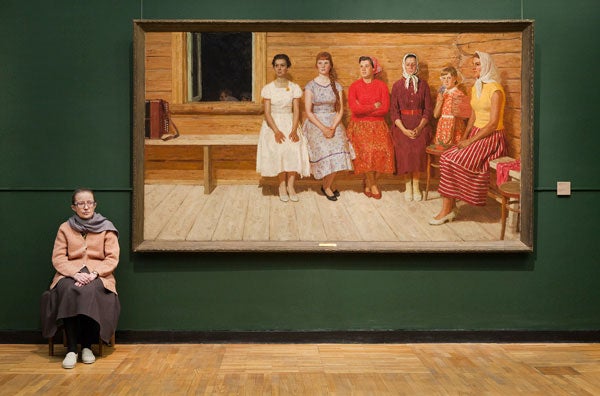|
July 25, 2012
Lens turned on museum guards in new exhibit at Stanford's Cantor Arts Center
A photojournalist surreptitiously captures in pictures female guards proudly protecting Russia's national treasures and becoming art subjects themselves. By Robin Wander

Guard with Yuri Kugach's 'Before the Dance,' State Tretyakov Gallery. (Photo: Andy Freeberg / Courtesy of Cantor Arts Center)
In 2008, San Francisco-based photojournalist Andy Freeberg set out for Russia to document the country's evolution since the glasnost and perestroika days of the USSR.
What he documented instead were older women in sensible shoes and careworn sweaters sitting sentinel in front of priceless masterpieces.
Freeberg's muse? The proud, protective Russian museum guards of St. Petersburg and Moscow.
Two of the gallery installations from Guardians: Photographs by Andy Freeberg, an Exhibition in Three Parts, on view at Stanford's Cantor Arts Center July 25–Jan. 6, 2013, feature 16 of the artist's portraits of Russian museum guards seated at their posts, seemingly unaware that they are being photographed.
The striking thing about the portraits is how Freeberg was able to capture the subjects unconsciously mirroring the artworks they are guarding by way of profile, posture or color.
Freeberg's portraits also convey the guards' sense of dignity and pride in their work.
Despite sitting for hours and earning little pay, the women project a sense of honor instead of duty. They function as a necessary line of defense in front of irreplaceable national treasures, but it is easy to imagine them offering you a wink and a hard candy.
The large-format photographs – cleverly installed in the permanent galleries where the photographed artwork finds peers in real-life examples from the same eras – are like portals into the Russian galleries.
Curator Elizabeth Kathleen Mitchell chose the 16 photographs of Russian guards from Freeberg's larger series and divided the works according to the objects depicted.
Photographs with objects dating from antiquity through the Enlightenment are installed in the Cantor's European 15th- to 18th-century paintings gallery, and photographs with objects dating from the 19th to the early 20th centuries are displayed in the Robert Mondavi Family Gallery, which is mostly 19th-century paintings.
"When you stand in these galleries, the objects in Andy's photographs speak to the Cantor collection objects around them," said Mitchell. "The photo installations become little museums within our museum, and encourage the viewer to think about the dynamics of the museum experience."
Candid camera
Aside from the fact that the Russian museum guards appear to be a homogenous corps of women of a certain age and museum security staff in the U.S. is more diverse, the two significant differences between guarding art in Russia and guarding art in this country is the uniform and the chair.
In Russia, guards wear their own clothes and sit in a chair. In the U.S., uniformed guards patrol on foot.
These differences made the serendipitous affinities between the guards and their protected objects in the Russian series possible.
Trading in his press pass for a tourist camera pass, Freeberg used a small 35-millimeter digital camera (Canon Eos 5D) and available light to inconspicuously create his portraits.
In one, he captures a guard wearing a deep blue shawl with a decorative pattern that closely resembles Henri Matisse's Still Life with Blue Tablecloth. In another, a formidable guard with close-cropped salt and pepper hair sits cross-armed between reproductions of Michelangelo sculptures. The woman's bare, beefy forearms relate to the muscular figures on either side of her and the cool gray palette unites the subjects.
The guard in front of Yuri Kagach's Before the Dance sitting with hands clasped in solidarity with her painted sisters looks like she easily could be waiting for the music to start.
Throughout the 16 photographs you notice the synchronized tilt of the head here, or a repeated posture there, and sometimes colors connecting sitter and object.
Mitchell writes in her introduction to the series: "As a whole, the exhibition invites reflection on the museum as a social space. On one hand, a museum is an artificial environment with specific visitor rules and employee protocols. At the same time, the galleries enable both visitors and staff to have a very human experience by interacting with the art and each other."
A nod to the local guard
The third installation from the Cantor's Freeberg project is the student-artist collaboration Guards on Film: Andy Freeberg and Cantor Arts Center Security Staff.
Curated by undergraduate Josie Johnson, the project presents four new photographs that the Cantor invited Freeberg to take of the Cantor security staff in front of their favorite pieces along with a short documentary film produced by Justin Warren, '09, and directed by Johnson.
Unlike the Russian series that was photographed with museum permission but without artist-subject collaboration, the Cantor series is composed to purposefully create relationships between the human subjects and the artwork.
Officer Carol Wick is posed in her uniform standing at attention with her back to Christopher Brown's soldiers in Orders and facing Richard Diebenkorn's Window. A Cantor membership sticker on Steve Luebkeman's identification badge mimics the hellish reds in The Last Judgment by an unknown Peruvian artist.
These visual connections and echoes compel you to look closely at the Freeberg photographs and the artwork within.
In the film, the four security guards photographed by Freeberg talk about visitors and art in the collection and they make observations about the nature of guarding artwork.
"I very much enjoyed working with the guards. Their stories were often surprising, touching, or comical," said Johnson, a senior in the art history department with a minor in Russian language. "This experience has certainly changed the way I see museums and the artwork on the walls, and I now place greater value on spending time with an artwork in person, getting to know the piece the way the guards do."
-30-
|